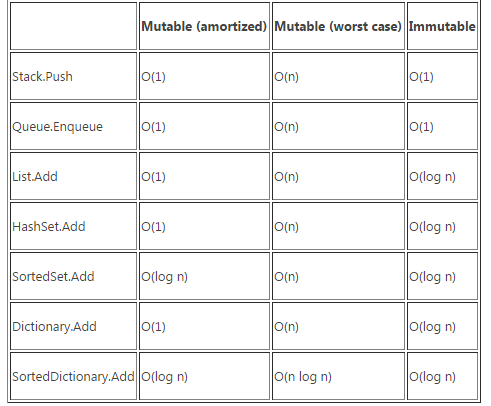探索C#之不可变数据类型
作者:网络转载 发布时间:[ 2015/9/7 10:56:44 ] 推荐标签:测试开发技术
自定义不可变集合
我们去枚举可变集合时,出于线程安全的考虑我们往往需要进行加锁处理,防止该集合在其他线程被修改,而使用不可变集合则能避免这个问题。我们平常使用的数据结构都是采用可变模式来实现的,那怎么实现一个不可变数据结构呢!以栈来示例,具体代码如下:
public interface IStack<T> : IEnumerable<T>
{
IStack<T> Push(T value);
IStack<T> Pop();
T Peek();
bool IsEmpty { get; }
}
public sealed class Stack<T> : IStack<T>
{
private sealed class EmptyStack : IStack<T>
{
public bool IsEmpty { get { return true; } }
public T Peek() { throw new Exception("Empty stack"); }
public IStack<T> Push(T value) { return new Stack<T>(value, this); }
public IStack<T> Pop() { throw new Exception("Empty stack"); }
public IEnumerator<T> GetEnumerator() { yield break; }
IEnumerator IEnumerable.GetEnumerator() { return this.GetEnumerator(); }
}
private static readonly EmptyStack empty = new EmptyStack();
public static IStack<T> Empty { get { return empty; } }
private readonly T head;
private readonly IStack<T> tail;
private Stack(T head, IStack<T> tail)
{
this.head = head;
this.tail = tail;
}
public bool IsEmpty { get { return false; } }
public T Peek() { return head; }
public IStack<T> Pop() { return tail; }
public IStack<T> Push(T value) { return new Stack<T>(value, this); }
public IEnumerator<T> GetEnumerator()
{
for (IStack<T> stack = this; !stack.IsEmpty; stack = stack.Pop())
yield return stack.Peek();
}
IEnumerator IEnumerable.GetEnumerator() { return this.GetEnumerator(); }
}
入栈时会实例化一个新栈对象
将新值通过构造函数传入,并存放在新对象Head位置,旧栈对象放在在Tail位置引用
出栈时返回当前栈对象的Tail引用的栈对象
使用方法如下:
IStack<int> s1 = Stack<int>.Empty;
IStack<int> s2 = s1.Push(10);
IStack<int> s3 = s2.Push(20);
IStack<int> s4 = s3.Push(30);
IStack<int> v3 = s4.Pop();
foreach (var item in s4)
{
//dosomething
}
每次Push都是一个新对象,旧对象不可修改,这样在枚举集合不需要担心其他线程修改了。
Net提供的不可变集合
不可变队列,不可变列表等数据结构如果都自己实现工作量确实有点大。幸好的是Net在4.5版本已经提供了不可变集合的基础类库。 使用Nuget安装:
Install-Package Microsoft.Bcl.Immutable
使用如下,和上面我们自定义的几乎一样:
ImmutableStack<int> a1 = ImmutableStack<int>.Empty;
ImmutableStack<int> a2 = a1.Push(10);
ImmutableStack<int> a3 = a2.Push(20);
ImmutableStack<int> a4 = a3.Push(30);
ImmutableStack<int> iv3 = a4.Pop();
使用Net不可变列表集合有一点要注意的是,当我们Push值时要重新赋值给原变量才正确,因为push后会生成一个新对象,原a1只是旧值:
ImmutableStack<int> a1 = ImmutableStack<int>.Empty;
a1.Push(10);
//不正确,a1仍是空值值,push会生成新的栈。
a1 = a1.Push(10);
//需要将新栈重新赋值给a1
NET提供的常用数据结构
ImmutableStack
ImmutableQueue
ImmutableList
ImmutableHashSet
ImmutableSortedSet
ImmutableDictionary<K, V>
ImmutableSortedDictionary<K, V>
不可变集合和可变集合在算法复杂度上的不同:

本文内容不用于商业目的,如涉及知识产权问题,请权利人联系SPASVO小编(021-61079698-8054),我们将立即处理,马上删除。
相关推荐

更新发布
功能测试和接口测试的区别
2023/3/23 14:23:39如何写好测试用例文档
2023/3/22 16:17:39常用的选择回归测试的方式有哪些?
2022/6/14 16:14:27测试流程中需要重点把关几个过程?
2021/10/18 15:37:44性能测试的七种方法
2021/9/17 15:19:29全链路压测优化思路
2021/9/14 15:42:25性能测试流程浅谈
2021/5/28 17:25:47常见的APP性能测试指标
2021/5/8 17:01:11热门文章
常见的移动App Bug??崩溃的测试用例设计如何用Jmeter做压力测试QC使用说明APP压力测试入门教程移动app测试中的主要问题jenkins+testng+ant+webdriver持续集成测试使用JMeter进行HTTP负载测试Selenium 2.0 WebDriver 使用指南














 sales@spasvo.com
sales@spasvo.com